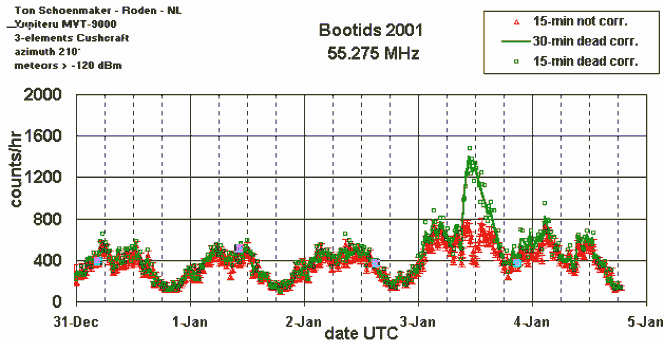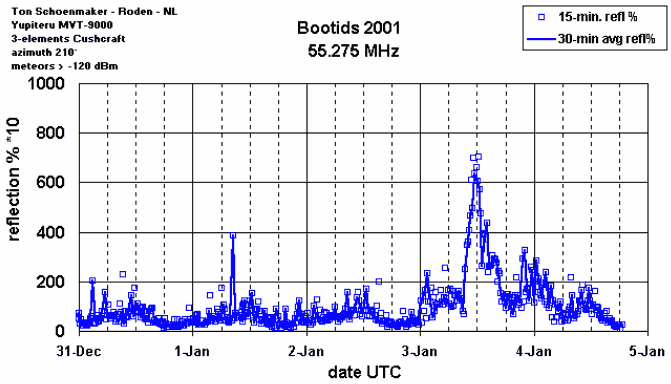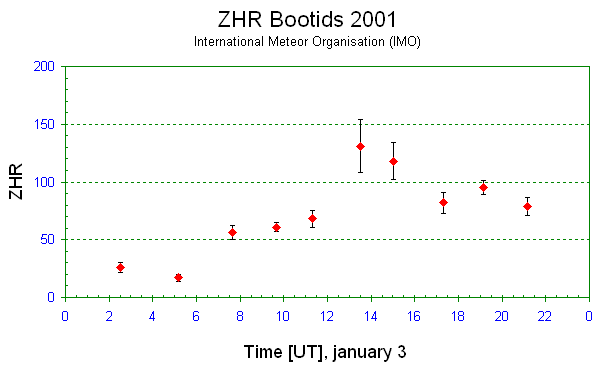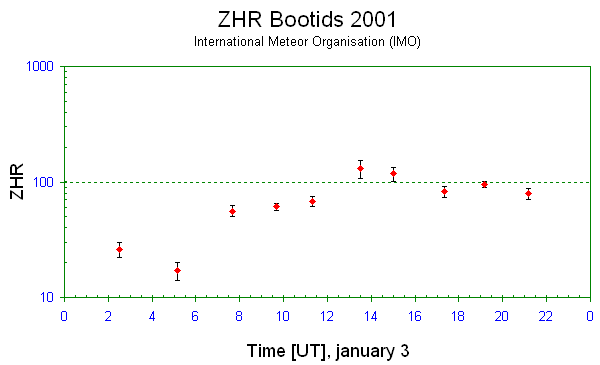 Carl Johannink : visual observations Carl Johannink : visual observations |
 Arnold Tukkers : visual observations Arnold Tukkers : visual observations |
 Ton Schoenmaker : forward scatter observations Ton Schoenmaker : forward scatter observations |
 IMO Shower Circular IMO Shower Circular |
 Quadrantids 2001 (Science@NASA) Quadrantids 2001 (Science@NASA) |
 Gary Kronk Gary Kronk |
Carl Johannink, Gronau
Date : 03/04-01-2001 Observer: Johannink, Carl (IMO-code: JOHCA) Place : Gronau (Germany) Coord. : 7°04'E ; 52°15'N (!!) Center : R.A.=22h00m; Decl.=70 deg. at 17:30 UT Start : 17:08 UT End : 18:49 UT Teff : 1.60 hours Time(UT) Qua Com sp n LM Notes ------------------------------------------- 17:08-18:04 10 0 4 14 5.2 0.85 hours 18:04-18:49 5 0 5 10 5.4 0.75 hours <-2 -2 -1 0 1 2 3 4 5 6 m n QUA. 0 0 1 2 2 1 5 4 0 0 2.27 15 COM. 0 Spo. 0 0 0 0 1 0 2 6 0 0 3.44 9 =========================================== C.F. Johannink Schiefestrasse 36 48599 Gronau Germany Phone: + 49 2562 22345 Email: cjohannink@netside.de
Arnold Tukkers, Denekamp
Observer: Results Arnold Tukkers(ATL) Date : 3/4 january 2001 Time : 18:45 UT - 20:45 UT T.eff : 2 Place : Denekamp 52°22' - 7°00' Number of meteors: 16 PERIODE Tm Teff Lm QUA SPO DCA Ntot --------------------------------------------------- 18:45 - 19:00 19:00 0.5 4.9 2 2 4 19:15 - 19:45 19:30 0.5 5.0 2 1 2 5 19:45 - 20:15 20:00 0.5 5.0 3 1 1 5 20:15 - 20:45 20:30 0.5 5.0 1 1 2 ZWERM 0 1 2 3 4 5 N N~ %~ M --------------------------------------------------- QUA 1 2 5 8 0 0 3,5 SPOR 1 1 3 5 0 0 4,4 DCA 1 2 3 0 0 3,3
Ton Schoenmaker, Roden
Observer: Ton Schoenmaker
Location: Roden, Netherlands (06º26'E, 53º08'N)
Frequency: 55.275 MHz
Transmitter: Spanish TV channel E3 (video); transmitters in La Muela (30 kW),
Gamoniteiro (50 kW) and Aitana (60 kW); all stations within
100 Hz of nominal frequency; distance ~1500 km
Antenna: 3-elements horizontal Cushcraft 50 MHz Yagi tuned to 55.3 MHz;
geographical azimuth 210 degrees (SW)
Receiver: Yupiteru MVT-9000 in USB mode; sensitivity 0.5 uV at 12 dB S/N
Observing: 800 Hz audio signal from earphone socket was rectified, digitised
and fed into a PC via the parallel computer port. HP VEE was used
to process the digitised signal and to store 15-minutes counts of
reflections stronger than 0.22 uV (-120 dBm). Also for all
individual meteors date, time, duration (dead time) and maximum
signal are stored.
Figure 1 shows the uncorrected (red) and dead time corrected (green) results of forward scatter observations of the Quadrantids. A maximum was observed on 3 January 2001 around 12h UTC. Figure 2 shows the reflection percentages (dead time). Due to pointing of the antenna (about SW), observability for the Quadrantids was low around 8h and 23h30m, and high around 5h and 11h UTC. The (partly) corrected data still have to be corrected for the observability function.

Figure 1. Uncorrected and dead time corrected forward scatter observations of the Quadrantids. The observability function was low around 8h , 20h30m and 23h30m, and high around 5h and 11h UTC.

Figure 2. Uncorrected reflection percentages (dead time) of Quadrantids. The activity of the Quadrantids started around midnight 2/3 January 2001 and lasted until the early hours of 4 January.
Ton Schoenmaker, Dutch Meteor Society and IMO
Meester Homanstraat 8, NL 9301 HP Roden, Netherlands
E-mail: schoenmaker@NFRA.nl
Call: PA0EFA
Rainer Arlt & Vladimir Krumov
Favorable lunar conditions accompanied the maximum of the 2001 Quadrantid meteor shower. Peak activity was expected near 12h UT on January 3, corresponding to a solar longitude of lambda=283.16 deg.
Observers were satisfied by good Quadrantid rates in the UT afternoon and evening hours of January 3, 2001. Radio forward- scatter observations as reported by Hiroshi Ogawa, Japan, showed increased Quadratid activity until 20h UT on January 3, compared with the background activity of December 30-January 1. Geometrical effects of radiant direction changes will play a significant role though.
The highest ZHR value is found for 13h30m UT on January 3 or a solar longitude of lambda=283.24 deg (J2000.0). The ZHR of about 130 is a typical value for the Quadrantids, but the number of reports for the peak period is very small whence conclusions are tentative. The peak time may easily shift by one hour to either side once a more comprehensive dataset is available.
We are very grateful to the following 23 observers who sent their reports to the Visual Commission or to the various mailing lists in time for this first activity overview:
ANDBI Birger Andresen (Norway) MEIMA Marcel Meima (UK) BIVNI Nicolas Biver(USA) NICTE Ted A. Nichols II (USA) BURWI Wlliam Burton (USA) PUNNI Nilesh Puntambekar (India) DAVMA Mark Davis (USA) RENJU Jurgen Rendtel (Germany) GLIGE George W. Gliba (USA) SPAGE George Spalding(UK) GODSH Shelagh Godwin (UK) STOWE Wes Stone (USA) HALWA Wayne T. Hally (USA) TAIRI Richard Taibi (USA) HASTA Takema Hashimoto (Japan) TUKAR Arnold Tukkers (the Netherlands) HOSDA Dave Hostetter (USA) UCHSH Shigeo Uchiyama (Japan) JOHCA Carl Johannink (Germany) YOUKI Kim S. Youmans (USA) LINMI Mike Linnolt (USA) ZHUJI Jin Zhu (China) MCBAL Alastair McBeath (UK) --------------------------------------------------- Date Time (UT) Sollong nObs nIND nQUA ZHR --------------------------------------------------- Jan 02 2300 282.63 2 2 17 13 +- 9 Jan 03 0230 282.78 5 3 40 26 +- 4 Jan 03 0510 282.89 13 5 109 17 +- 3 Jan 03 0740 283.00 9 5 98 56 +- 6 Jan 03 0940 283.08 10 8 192 61 +- 4 Jan 03 1120 283.15 6 4 90 68 +- 7 Jan 03 1330 283.24 3 2 33 131 +-23 Jan 03 1500 283.31 4 3 53 118 +-16 Jan 03 1720 283.41 5 3 76 82 +- 9 Jan 03 1910 283.48 10 5 217 95 +- 6 Jan 03 2110 283.57 5 4 98 79 +- 8 Jan 04 0400 283.86 2 1 19 16 +- 4 ---------------------------------------------------
Solar longitudes refer to equinox J2000.0. nObs is the number of individual observing periods, nIND is the number of individ- ual observers providing them, nQUA is the number of Quadrantids seen. The radiant position was assumed at alpha=230, delta=+49, the population index used was r=2.1. The expectation value of the ZHR,
ZHR = (1 + sum nQUA) / sum(Teff/C),
was used for the averages here, where Teff is the effective observing time and C is the total correction composed of limiting magnitude, clouds, and zenith correction. Times are rounded to the nearest 10 minutes.
Rainer Arlt & Vladimir Krumov,
2001 January 4
--
Visual Commission - International Meteor Organization -- www.imo.net

